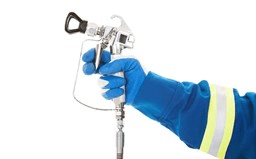Airless sprayers work by pumping high-pressure paints or coatings through a hose to the nozzle of the spray gun. As the paint is forced through the tip of the nozzle, it gets broken up (atomized) into fine droplets that form the spray pattern. Airless sprayers are so called because the paint is pumped through the system under high pressure as opposed to using compressed air.
Although airless sprayers offer many advantages over traditional compressed air methods, they are known for having low transfer efficiency, i.e., the ratio of the amount of paint that makes it to the surface versus the amount that gets lost or dispersed in the atmosphere. For example, a transfer efficiency of 80% means that 80% of the paint sprayed was successful in reaching the surface while the remaining 20% was wasted.
The transfer efficiency of airless spraying can be problematic when it comes to anti-corrosive coatings with a high solvent content. While solvents are useful for lowering the viscosity of the coating, they frequently contain high amounts of volatile organic compounds (VOCs) and hazardous air pollutants (HAPs). These compounds are toxic and can cause several health problems if inhaled or ingested. Airless spraying methods can significantly increase the rate of emission of VOCs and HAPs due to the dispersion of the wasted paint into the atmosphere.
In an attempt to reduce the number of airborne contaminants released by airless spraying, many industries have turned to coatings with less solvent content. These coatings are known as high solids coatings and naturally have a much lower VOC and HAP content.
In cases where high solids coatings are not feasible, other spraying technologies with higher transfer efficiencies such as air-assisted, electrostatic and rotary atomizer methods can be used to minimize the dispersion of toxic chemicals. Another option is to perform the coating operating within a spray booth, which has been shown to reduce both VOC emissions and cost. (Further discussion about coating selection can be found in the article Tightrope: Identifying Limiting Conditions for Coatings Specification.)

Figure 1. Airless spray equipment.